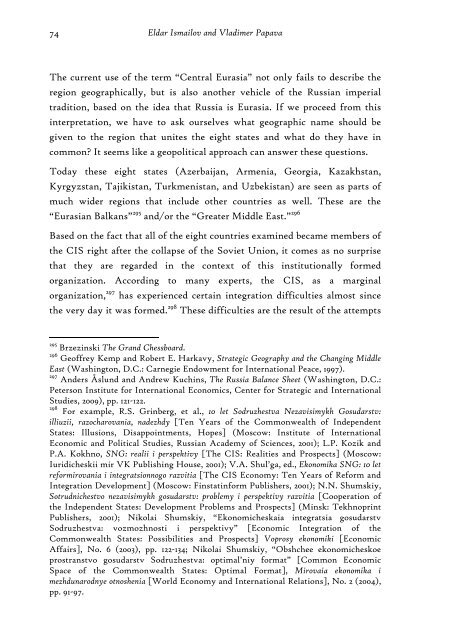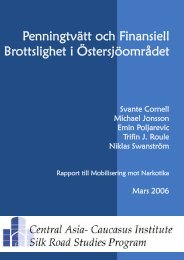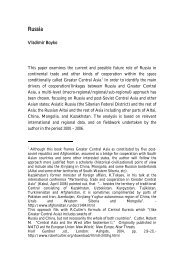Eurasianism and the Concept of Central Caucaso-Asia
Eurasianism and the Concept of Central Caucaso-Asia
Eurasianism and the Concept of Central Caucaso-Asia
Create successful ePaper yourself
Turn your PDF publications into a flip-book with our unique Google optimized e-Paper software.
74<br />
Eldar Ismailov <strong>and</strong> Vladimer Papava<br />
The current use <strong>of</strong> <strong>the</strong> term “<strong>Central</strong> Eurasia” not only fails to describe <strong>the</strong><br />
region geographically, but is also ano<strong>the</strong>r vehicle <strong>of</strong> <strong>the</strong> Russian imperial<br />
tradition, based on <strong>the</strong> idea that Russia is Eurasia. If we proceed from this<br />
interpretation, we have to ask ourselves what geographic name should be<br />
given to <strong>the</strong> region that unites <strong>the</strong> eight states <strong>and</strong> what do <strong>the</strong>y have in<br />
common? It seems like a geopolitical approach can answer <strong>the</strong>se questions.<br />
Today <strong>the</strong>se eight states (Azerbaijan, Armenia, Georgia, Kazakhstan,<br />
Kyrgyzstan, Tajikistan, Turkmenistan, <strong>and</strong> Uzbekistan) are seen as parts <strong>of</strong><br />
much wider regions that include o<strong>the</strong>r countries as well. These are <strong>the</strong><br />
“Eurasian Balkans” 295 <strong>and</strong>/or <strong>the</strong> “Greater Middle East.” 296<br />
Based on <strong>the</strong> fact that all <strong>of</strong> <strong>the</strong> eight countries examined became members <strong>of</strong><br />
<strong>the</strong> CIS right after <strong>the</strong> collapse <strong>of</strong> <strong>the</strong> Soviet Union, it comes as no surprise<br />
that <strong>the</strong>y are regarded in <strong>the</strong> context <strong>of</strong> this institutionally formed<br />
organization. According to many experts, <strong>the</strong> CIS, as a marginal<br />
organization, 297 has experienced certain integration difficulties almost since<br />
<strong>the</strong> very day it was formed. 298 These difficulties are <strong>the</strong> result <strong>of</strong> <strong>the</strong> attempts<br />
295 Brzezinski The Gr<strong>and</strong> Chessboard.<br />
296 Ge<strong>of</strong>frey Kemp <strong>and</strong> Robert E. Harkavy, Strategic Geography <strong>and</strong> <strong>the</strong> Changing Middle<br />
East (Washington, D.C.: Carnegie Endowment for International Peace, 1997).<br />
297 Anders Åslund <strong>and</strong> Andrew Kuchins, The Russia Balance Sheet (Washington, D.C.:<br />
Peterson Institute for International Economics, Center for Strategic <strong>and</strong> International<br />
Studies, 2009), pp. 121-122.<br />
298 For example, R.S. Grinberg, et al., 10 let Sodruzhestva Nezavisimykh Gosudarstv:<br />
illiuzii, razocharovania, nadezhdy [Ten Years <strong>of</strong> <strong>the</strong> Commonwealth <strong>of</strong> Independent<br />
States: Illusions, Disappointments, Hopes] (Moscow: Institute <strong>of</strong> International<br />
Economic <strong>and</strong> Political Studies, Russian Academy <strong>of</strong> Sciences, 2001); L.P. Kozik <strong>and</strong><br />
P.A. Kokhno, SNG: realii i perspektivy [The CIS: Realities <strong>and</strong> Prospects] (Moscow:<br />
Iuridicheskii mir VK Publishing House, 2001); V.A. Shul’ga, ed., Ekonomika SNG: 10 let<br />
reformirovania i integratsionnogo razvitia [The CIS Economy: Ten Years <strong>of</strong> Reform <strong>and</strong><br />
Integration Development] (Moscow: Finstatinform Publishers, 2001); N.N. Shumskiy,<br />
Sotrudnichestvo nezavisimykh gosudarstv: problemy i perspektivy razvitia [Cooperation <strong>of</strong><br />
<strong>the</strong> Independent States: Development Problems <strong>and</strong> Prospects] (Minsk: Tekhnoprint<br />
Publishers, 2001); Nikolai Shumskiy, “Ekonomicheskaia integratsia gosudarstv<br />
Sodruzhestva: vozmozhnosti i perspektivy” [Economic Integration <strong>of</strong> <strong>the</strong><br />
Commonwealth States: Possibilities <strong>and</strong> Prospects] Voprosy ekonomiki [Economic<br />
Affairs], No. 6 (2003), pp. 122-134; Nikolai Shumskiy, “Obshchee ekonomicheskoe<br />
prostranstvo gosudarstv Sodruzhestva: optimal’niy format” [Common Economic<br />
Space <strong>of</strong> <strong>the</strong> Commonwealth States: Optimal Format], Mirovaia ekonomika i<br />
mezhdunarodnye otnoshenia [World Economy <strong>and</strong> International Relations], No. 2 (2004),<br />
pp. 91-97.






